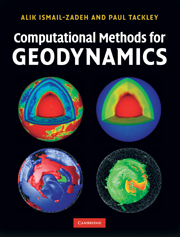Book contents
- Frontmatter
- Contents
- Foreword by Gerald Schubert
- Preface
- Acknowledgements
- 1 Basic concepts of computational geodynamics
- 2 Finite difference method
- 3 Finite volume method
- 4 Finite element method
- 5 Spectral methods
- 6 Numerical methods for solving linear algebraic equations
- 7 Numerical methods for solving ordinary and partial differential equations
- 8 Data assimilation methods
- 9 Parallel computing
- 10 Modelling of geodynamic problems
- Appendix A Definitions and relations from vector and matrix algebra
- Appendix B Spherical coordinates
- Appendix C Freely available geodynamic modelling codes
- References
- Author index
- Subject index
- Plates section
Appendix B - Spherical coordinates
Published online by Cambridge University Press: 05 June 2012
- Frontmatter
- Contents
- Foreword by Gerald Schubert
- Preface
- Acknowledgements
- 1 Basic concepts of computational geodynamics
- 2 Finite difference method
- 3 Finite volume method
- 4 Finite element method
- 5 Spectral methods
- 6 Numerical methods for solving linear algebraic equations
- 7 Numerical methods for solving ordinary and partial differential equations
- 8 Data assimilation methods
- 9 Parallel computing
- 10 Modelling of geodynamic problems
- Appendix A Definitions and relations from vector and matrix algebra
- Appendix B Spherical coordinates
- Appendix C Freely available geodynamic modelling codes
- References
- Author index
- Subject index
- Plates section
Summary
B1 Spherical grids
The main problem with modelling a sphere is that a simple (longitude, latitude) grid contains a singularity at the poles, where the grid lines of longitude converge. While this does not matter when the equations are solved and time-stepped in spectral space by the spectral transform method (Chapter 5), when using a spatial discretisation this grid convergence gives severely non-uniform resolution, can lead to convergence problems with iterative solvers and forces a small time step if using explicit time-stepping. Although some codes have successfully used such a grid (see Zebib et al., 1980; Kageyama and Sato, 1995; Iwase and Honda, 1997; Trubitsyn and Rykov, 2000), it is far from optimal. An optimal grid would have approximately uniform resolution over the spherical surface, and if it is desired to use a finite difference (FD) or straightforward finite volume (FV) approach, the grid lines should be orthogonal. Various grids have been used and are reviewed here and illustrated in Fig. B1.
Several grids arise from projecting Platonic solids onto a sphere then subdividing each face. One the earliest such grids is the isocahedral grid (Fig. B1a,b), as utilised in the FE code TERRA (Baumgardner, 1985; Baumgardner and Frederickson, 1985; Baumgardner, 1988). The resulting cells or elements are triangular on the 2-D sphere; TERRA uses elements that are triangular prisms in 3-D.
Information
- Type
- Chapter
- Information
- Computational Methods for Geodynamics , pp. 258 - 263Publisher: Cambridge University PressPrint publication year: 2010
